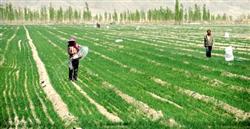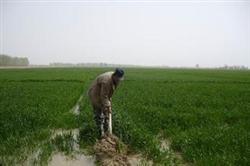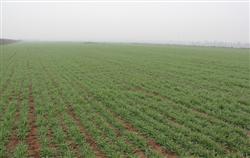Management and Prevention of four pests of Wheat in Spring

The spring management of wheat plays a decisive role in wheat yield. Therefore, to manage the wheat field well in spring and prevent the occurrence of the "four evils" is the key to ensure a bumper wheat harvest. Apply sufficient base fertilizer to prevent and control "fertilizer damage", apply 5000 kg of organic fertilizer, 20 kg of urea or 40 kg of ammonium bicarbonate or 30 kg of diammonium phosphate, 10 kg of potassium sulfate, 5 kg of special micro-fertilizer for wheat, 20 kg of diammonium phosphate per mu, 5 kg of potassium sulfate per mu, 10 kg of urea when raising the flag or 0.3% of potassium dihydrogen phosphate solution during the filling period. It is necessary to apply formula fertilizer and avoid single application of chemical fertilizer, and the proportion (nutrient content) of the formula (nutrient content) is NRV PRV 3KLV 1RU 3.When applying organic fertilizer, we must use mature organic fertilizer instead of "raw" fertilizer to prevent the effect of "raw" fertilizer on wheat root system. Attention should be paid to fertilization methods and techniques when fertilizing. After chemical fertilizer is applied to the ground, it should be applied more than 5 cm deep, covering the soil, not shallow or naked, so as to prevent volatilization from causing "burning" of wheat seedlings. To prevent and control "water damage", drainage ditches should be dug around the wheat field so that the excess water can flow away due to excessive watering; when preparing the wheat field, the soil should be broken, the land should be flat, and there should be no uneven plots to facilitate watering; when watering wheat, pay attention to the amount of watering is not too large, it is appropriate to seep down within 2 hours after watering, and do not leave "bright water" overnight. If you need to grow wheat in plots where the groundwater level is too shallow, find ways to dig ditches around so that the groundwater can seep into the ditches and make the wheat grow safely. When using pesticides to control diseases and insect pests, we must do a good job in the prediction and forecast of diseases and insect pests, so as to avoid unnecessary prevention and control, resulting in a waste of human, material and financial resources. The concentration of pesticides should not be too high or too small, too big wheat is harmful to the environment, and too small is disadvantageous to the prevention and control of diseases and insect pests, resulting in continuous and repeated use of drugs, which increases expenditure, and also pollutes the environment. Pesticides should be used in the right way to control insect pests. Drugs for pest control cannot be used to control diseases, and drugs for disease control can not be used to control insect pests. The use of technology and methods should be correct, the spray should be sprayed, and the root irrigation should be irrigated; after the medicine is used, it should be washed clean with alkali water to prevent it from being used again after spraying herbicides, causing drug damage to wheat. In order to prevent and control the wheat fields with excessive density of "heat damage", the techniques of paddling, deep ploughing and suppression should be adopted to limit the continuous increase of density in winter and early spring, so that the maximum seedling density is about 800000 / mu in winter and 100-1.1 million / mu in spring. Less fertilizer, less nitrogen fertilizer, more phosphorus and potassium fertilizer In the process of managing wheat in spring, we must strengthen the management of moisture, and the lack of water can easily cause the harm of dry and hot wind; strengthen spring management measures to make wheat roots developed, stems and stems strong, and rely on their own ability to resist dry and hot wind; if dry and hot wind occurs, the roots are protected by supplementary application of "Maifeng", "photosynthetic micro-fertilizer", "naphthylacetic acid" and so on.
- Prev

Early prevention of wheat diseases and insect pests in spring
Watering from the point of view of water-saving, it is recommended that wheat should be watered two times in spring. if the soil moisture is good in the normal wheat field, it can not be irrigated back to green water. The spring watering time of wheat should be in the jointing stage (from late March to early April), and the specific watering time should be watered in the heading and flowering stage (from late April to early May).
- Next

The spring tube of wheat focuses on fertilizer and water.
It is common to crack down on hoes and rakes at the top. Rake or suppression can crush soil blocks, settle soil, increase soil moisture and preserve soil moisture, transfer deep water, and promote roots and tillers. Through suppression, capillaries in the soil are formed, and the deep soil moisture rises to the upper soil along the capillaries, which is beneficial to nourish the root growth. Hoe and rake in early spring.
Related
- The first cup of black tea in spring, the flavor and history of tea gardens in Kenya, Africa
- The computer can not only choose potatoes, but also grow tea rice. AI will grow winter oolong tea champion.
- It is not only the inflated tea bitten by insects, but also engraved with the four seasons tea in Beipu.
- The Oriental Beauty Tea Festival in Zhuxian County takes the stage at the weekend to experience the plus-size feast of oil tea.
- & quot; Oriental Beauty Tea & Exploration of Emei in Hsinchu, the hometown of quot;
- The new variety of strawberry "Tainong 1" dessert is the first choice with mellow aroma. Crimson gorgeous
- History of Tea in Taiwan: from Wild Inner Mountain to Export Tea Garden
- Two types of Taiwan Oriental Beauty Black Tea won the British three-Star Award for Childhood Tea Xiang Zhang Jiaqi changed from pilot to champion tea maker.
- Banana species and varieties: the planting history of Taiwan Xianren banana and dwarf banana is long, is banana disease resistant?
- Coffee planting Technology: Qianjie Coffee from Seedling to harvesting

